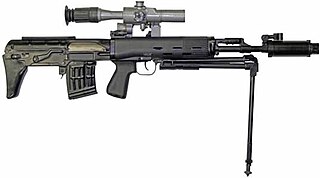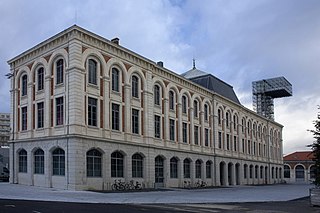
The Colt AR-15 is a lightweight, magazine-fed, gas-operated semi-automatic rifle. It is a semi-automatic version of the M16 rifle sold for the civilian and law enforcement markets in the United States. The AR in AR-15 stands for ArmaLite rifle, after the company that developed it in the 1950s. Colt's Manufacturing Company currently owns the AR-15 trademark, which is used exclusively for its line of semi-automatic AR-15 rifles.

A bullpup firearm is one with its firing grip located in front of the breech of the weapon, instead of behind it. This creates a weapon with a shorter overall length for a given barrel length, and one that is often lighter, more compact, concealable and more maneuverable than a conventionally configured firearm. Where it is desirable for troops to be issued a more compact weapon, the use of a bullpup configuration allows for barrel length to be retained, thus preserving muzzle velocity, range and ballistic effectiveness.
The M14 rifle, officially the United States Rifle, Caliber 7.62 mm, M14, is an American select fire battle rifle chambered for the 7.62×51mm NATO cartridge. It became the standard-issue rifle for the U.S. military in 1957, replacing the M1 Garand rifle in service with the U.S. Army by 1958 and the U.S. Marine Corps by 1965; deliveries of service rifles to the U.S. Army began in 1959. The M14 was used by the U.S. Army, Navy, and Marine Corps for Basic and Advanced Individual Training from the mid-1960s to the early 1970s.

The Lebel Model 1886 rifle also known as the "Fusil Mle 1886 M93", after a bolt modification was added in 1893, is an 8 mm bolt-action infantry rifle that entered service in the French Army in 1887. It is a repeating rifle that can hold eight rounds in its fore-stock tube magazine, one round in the elevator plus one round in the chamber; equaling a total of ten rounds held. The Lebel rifle has the distinction of being the first military firearm to use smokeless powder ammunition. The new propellant powder, "Poudre B," was nitrocellulose-based and had been invented in 1884 by French chemist Paul Vieille. Lieutenant Colonel Nicolas Lebel contributed a flat nosed 8 mm full metal jacket bullet. Twelve years later, in 1898, a solid brass pointed (spitzer) and boat-tail bullet called "Balle D" was retained for all 8mm Lebel ammunition. Each case was protected against accidental percussion inside the tube magazine by a primer cover and by a circular groove around the primer cup which caught the tip of the following pointed bullet. Featuring an oversized bolt with front locking lugs and a massive receiver, the Lebel rifle was a durable design capable of long range performance. In spite of early obsolete features, such as its tube magazine and the shape of 8mm Lebel rimmed ammunition, the Lebel rifle remained the basic weapon of French infantry during World War I (1914–1918). Altogether, 3.45 million Lebel rifles were produced by the three French state factories between 1887 and 1916.

Direct impingement is a type of gas operation for a firearm that utilizes gas from a fired cartridge to impart force on the bolt carrier or slide assembly to cycle the action. Firearms using direct impingement are theoretically lighter, more accurate, and less expensive than firearms using cleaner and cooler gas piston systems.

Selective fire, or select fire, is the capability of a weapon to be adjusted to fire in semi-automatic, fully automatic, and/or burst mode. The modes are chosen by means of a selector switch, which varies depending on the weapon's design. Some selective-fire weapons have burst fire mechanisms to limit the maximum number of shots fired automatically in this mode. The most common limits are two or three rounds per trigger pull. Fully automatic fire refers to the ability for a weapon to fire continuously until either the feeding mechanism is emptied or the trigger is released. Semi-automatic refers to the ability to fire one round per trigger pull.

A battle rifle is a service rifle chambered to fire a fully powered cartridge.

The MAS-49 is a French semi-automatic rifle that replaced various bolt-action rifles as the French service rifle that was produced from 1949. It was designed and manufactured by the government-owned MAS arms factory. The French Army formal designation of the MAS-49 is Fusil semi-automatique 7 mm 5 M. 49.

Eugene Morrison Stoner was an American machinist and firearms designer who is most associated with the development of the ArmaLite AR-15 rifle that was redesigned and modified by Colt's Patent Firearm Company for the United States military as the M16 rifle.

Gas-operation is a system of operation used to provide energy to operate locked breech, autoloading firearms. In gas-operation, a portion of high-pressure gas from the cartridge being fired is used to power a mechanism to dispose of the spent case and insert a new cartridge into the chamber. Energy from the gas is harnessed through either a port in the barrel or a trap at the muzzle. This high-pressure gas impinges on a surface such as a piston head to provide motion for unlocking of the action, extraction of the spent case, ejection, cocking of the hammer or striker, chambering of a fresh cartridge, and locking of the action.
The Colt Automatic Rifle or Colt Light Machine Gun is a 5.56 mm NATO, open-bolt, full-automatic-only firearm developed by Colt Defense. It is based on the M16A2/A4, and has a distinctive squared-off handguard, vertical grip, carrying handle and integrated bipod.
The Meunier rifle, known as the "Meunier A6" or "STA No. 8", evolved as a part of the program initiated in 1890 by the French military to develop a semi-automatic infantry rifle that would eventually replace the Mle 1886–93 Lebel rifle. Four government research establishments proposed over 20 prototypes. About half of them were based on recoil and the others were gas operated. This secret program was placed under the direction of General Naquet-Laroque who headed the Puteaux (APX) government arsenal.

The Manufacture d'Armes de Saint-Étienne, often abbreviated to MAS, was a French state-owned weapons manufacturer in the town of Saint-Étienne, Loire. Founded in 1764, it was merged into the French state-owned defense conglomerate GIAT Industries in 2001.
Atelier Mécanique de Mulhouse (AME), formerly known as Centre d'Études et d'Armement de Mulhouse (CEAM), was a French small arms manufacturer which operated from 1946 to 1967.
Ludwig Vorgrimler is the man most commonly associated with the design of the Spanish roller-delayed CETME rifle, and its prolific offspring from the German gunmaker Heckler & Koch such as the G3, HK21, P9 and MP5.
The Sterling Engineering Company Ltd was an arms manufacturer based in Dagenham, famous for manufacturing the Sterling submachine gun (L2A3), ArmaLite AR-18 and Sterling SAR-87 assault rifles and parts of Jaguar cars. The company went bankrupt in 1988.
The SR-556 is a semi-automatic AR-15 style rifle manufactured by Sturm, Ruger & Co. The rifle was introduced in 2009 in .223 Remington/5.56×45mm NATO and as a .308 Winchester AR-10 variant in 2013, the SR-762. It is one of several AR-15 rifles to use a gas piston operation.
The Fusil Automatique Modèle 1917, also called the RSC M1917, was a gas-operated, semi-automatic rifle placed into service by the French Army during the latter part of World War I. It was chambered in 8mm Lebel, the rimmed cartridge used in other French Army infantry weapons of the time. In total, the French national armories, primarily Manufacture d'armes de Saint-Étienne (MAS) and Manufacture Nationale d'Armes de Tulle (MAT), manufactured 86,000 RSC M1917 rifles until production ended in late November 1918. However, very few examples have survived in fully-functional, semi-automatic condition and those have become highly sought-after collectibles.

The T48 was a battle rifle tested by the U.S. military in the mid 1950s during trials to find a replacement for the M1 Garand. It was a license-produced copy of the Belgian FN FAL rifle. The rifle did not enter service, as the U.S. military decided to adopt the M14 rifle instead.











